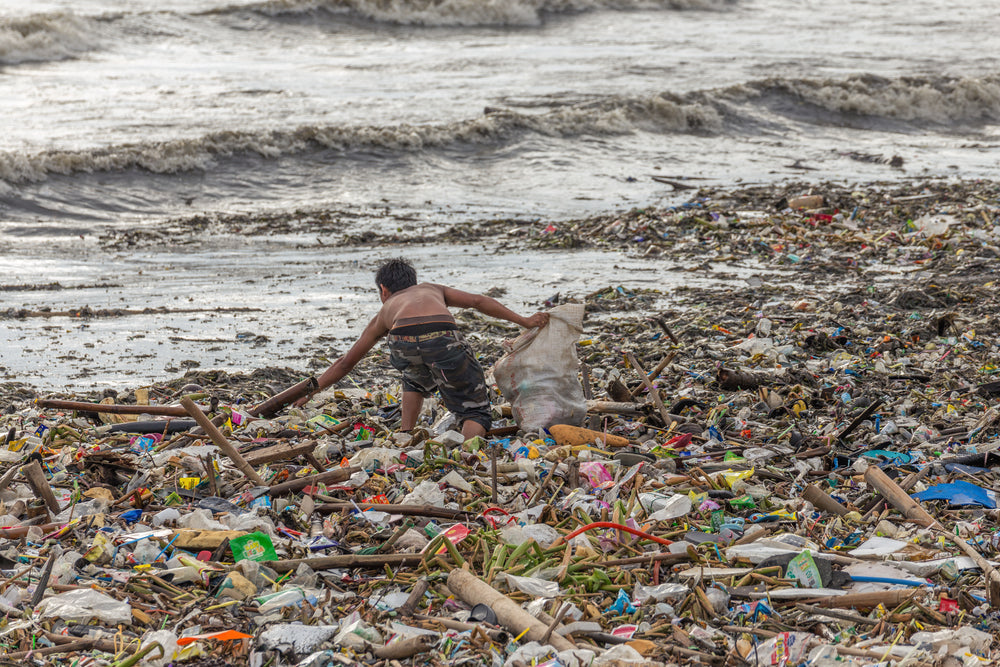Sustainable Development: Tackling Ocean Plastics
In the last post in our series exploring the importance of environmental justice and ho...

In the last post in our series exploring the importance of environmental justice and how it relates to ongoing discussions on social justice, we want to discuss why we use reclaimed ocean-bound plastic to manufacture packaging for cannabis products.
Today, we will explore the serious environmental and social consequences that result from the current proliferation of single-use plastics and the role using alternative materials plays in a circular economy and sustainable development.
Single-Use Plastic Waste: A Social and Environmental Issue
At Sana Packaging, we view ocean plastic - including ocean-bound plastic - as a stranded resource. We aim to remove plastic from the environment and reintroduce it to the marketplace and proper waste stream, contributing to sustainable packaging solutions.
The Environmental Impact of Single-Use Plastic Packaging
There truly is a dire need for sustainable packaging innovation in the modern era. Since we began mass-producing plastics in the 1950s, we've created over 8.3 billion metric tons of plastic. Of these 8.3 billion metric tons of plastic, only 9% has been recycled. 19% has been incinerated and the remaining 72% has ended up in our landfills and natural environment.
Waste management has become an even larger problem as our society continues to favor single-use containers as the main packaging for consumer packaged goods. The COVID-19 pandemic has exacerbated this trend, as many businesses have turned solely to utilizing single-use packaging to brand their products as safe amidst the pandemic.
The Social Impact of Unsustainable Plastic Packaging
The use of single-use plastic also has serious social consequences in addition to the environmental impacts, highlighting key social justice issues.
We know that plastics that aren't recycled properly disproportionately negatively impact lower-income communities in the United States and around the world. In our current system, developed countries often export their plastic waste. Instead of looking to address the problem internally and systemically, we are often simply passing it on to less-developed countries with disastrous results, raising concerns about social responsibility.
Plastic and Our Waterways
The plastic that doesn't end up in landfills in lower-income communities often enters our oceans and natural environment.
Over 11 million metric tons of plastic enter our oceans every year, and this plastic doesn't disappear overnight. Many of us have seen the haunting images of islands of consolidated garbage floating in our oceans worldwide and of animals getting trapped in plastic waste or mistaking it for food.
Plastic bags take roughly 20 years to break down, and bulkier items like plastic bottles take over 400 years to break down. In that time, we can cause irreparable damage to some of our planet's most precious ecosystems due to plastic pollution. If we don't address this problem with collective action from the business community, in addition to major systemic changes at the regulatory level, there will be more plastic than fish by volume in our oceans by 2050.
How Sustainable Cannabis Packaging Can Make a Difference
Although much of the information presented suggests a bleak picture of the future, we have a tremendous opportunity to create positive change when it comes to the plastic packaging issue in the cannabis industry, specifically through sustainable development and eco-friendly practices.
Creating Eco-Friendly Cannabis Containers with Reclaimed Ocean-Bound Plastic
Because we are still a developing industry, we can make sustainable packaging the industry standard from the ground up. This isn't to suggest that we view our utilization of reclaimed ocean plastic as the only, or even best, solution to our current waste problems. For a problem this large, no single solution will serve as a cure-all.
At Sana Packaging, our goal in utilizing reclaimed ocean-bound plastic is to limit our negative impact on the environment and low-income communities while helping others recognize the value in moving away from our traditional "take-make-dispose" economic model and transitioning to a circular economy.
What is Reclaimed Ocean Plastic?
There are five categories of reclaimed ocean plastics in terms of collection areas:
1. Ocean Bound
Material collected from communities without formal waste management within 50 kilometers of the shoreline. This terminology is in accordance with standards and research set by the renowned marine debris expert Jenna Jambeck.
2. Waterway
Material found in streams, rivers and other waterways flowing towards the ocean.
3. Coastal
Material that has washed up onto beaches and coastlines. Commonly fragmented and showing signs of degradation.
4. Near Shore
Material suspended in the shallow or adjacent areas of the ocean that are close but not accumulating on the shore line.
5. High Seas
Material far from shore, including accumulated floating "gyres." The collected materials are almost exclusively high-density polyethylene (HDPE), as these gyres float in ocean water.
Sana Packaging's Dedication to Cannabis Container Made from Reclaimed Ocean-Bound Plastic
The reclaimed ocean-bound plastic we use is, depending on the product, either a pure PET, pure HDPE, or pure PP.
We source our reclaimed ocean-bound plastic from a number of suppliers including Oceanworks, a global marketplace for reclaimed ocean materials that allows us to ensure that we are sourcing pure materials.
Currently, we use reclaimed ocean plastic to manufacture tubes, screw-top closures, and jars for cannabis products like pre-rolls, vape cartridges, flower, salves, and edibles.
We are continuously blown away by the innovative ways our customers use our reclaimed ocean-bound plastic packaging for their specific product needs, and we look forward to continuing to help remove plastic waste from the environment with our sustainable cannabis container solutions.
Written by Galen Kuney
